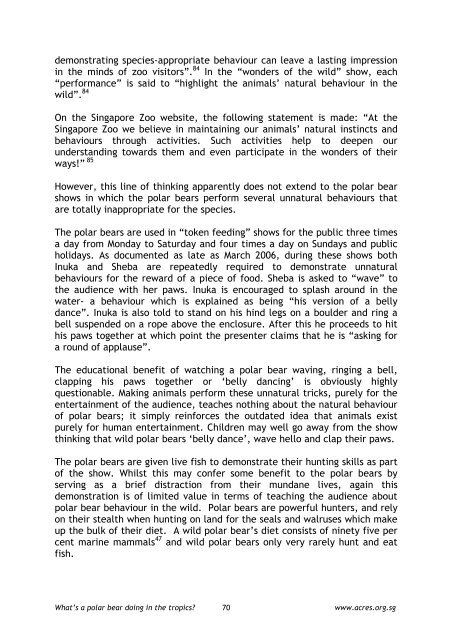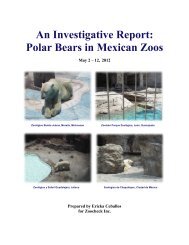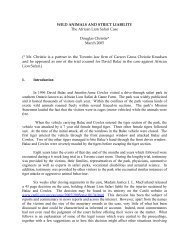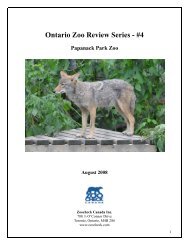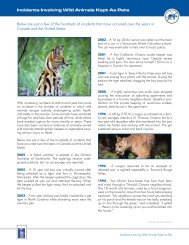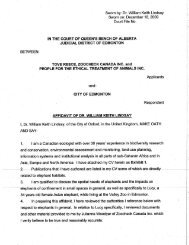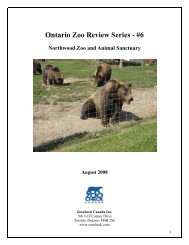What's a Polar Bear Doing in the Tropics? - Animal Concerns ...
What's a Polar Bear Doing in the Tropics? - Animal Concerns ...
What's a Polar Bear Doing in the Tropics? - Animal Concerns ...
You also want an ePaper? Increase the reach of your titles
YUMPU automatically turns print PDFs into web optimized ePapers that Google loves.
demonstrat<strong>in</strong>g species-appropriate behaviour can leave a last<strong>in</strong>g impression<strong>in</strong> <strong>the</strong> m<strong>in</strong>ds of zoo visitors”. 84 In <strong>the</strong> “wonders of <strong>the</strong> wild” show, each“performance” is said to “highlight <strong>the</strong> animals’ natural behaviour <strong>in</strong> <strong>the</strong>wild”. 84On <strong>the</strong> S<strong>in</strong>gapore Zoo website, <strong>the</strong> follow<strong>in</strong>g statement is made: “At <strong>the</strong>S<strong>in</strong>gapore Zoo we believe <strong>in</strong> ma<strong>in</strong>ta<strong>in</strong><strong>in</strong>g our animals’ natural <strong>in</strong>st<strong>in</strong>cts andbehaviours through activities. Such activities help to deepen ourunderstand<strong>in</strong>g towards <strong>the</strong>m and even participate <strong>in</strong> <strong>the</strong> wonders of <strong>the</strong>irways!” 85However, this l<strong>in</strong>e of th<strong>in</strong>k<strong>in</strong>g apparently does not extend to <strong>the</strong> polar bearshows <strong>in</strong> which <strong>the</strong> polar bears perform several unnatural behaviours thatare totally <strong>in</strong>appropriate for <strong>the</strong> species.The polar bears are used <strong>in</strong> “token feed<strong>in</strong>g” shows for <strong>the</strong> public three timesa day from Monday to Saturday and four times a day on Sundays and publicholidays. As documented as late as March 2006, dur<strong>in</strong>g <strong>the</strong>se shows bothInuka and Sheba are repeatedly required to demonstrate unnaturalbehaviours for <strong>the</strong> reward of a piece of food. Sheba is asked to “wave” to<strong>the</strong> audience with her paws. Inuka is encouraged to splash around <strong>in</strong> <strong>the</strong>water- a behaviour which is expla<strong>in</strong>ed as be<strong>in</strong>g “his version of a bellydance”. Inuka is also told to stand on his h<strong>in</strong>d legs on a boulder and r<strong>in</strong>g abell suspended on a rope above <strong>the</strong> enclosure. After this he proceeds to hithis paws toge<strong>the</strong>r at which po<strong>in</strong>t <strong>the</strong> presenter claims that he is “ask<strong>in</strong>g fora round of applause”.The educational benefit of watch<strong>in</strong>g a polar bear wav<strong>in</strong>g, r<strong>in</strong>g<strong>in</strong>g a bell,clapp<strong>in</strong>g his paws toge<strong>the</strong>r or ‘belly danc<strong>in</strong>g’ is obviously highlyquestionable. Mak<strong>in</strong>g animals perform <strong>the</strong>se unnatural tricks, purely for <strong>the</strong>enterta<strong>in</strong>ment of <strong>the</strong> audience, teaches noth<strong>in</strong>g about <strong>the</strong> natural behaviourof polar bears; it simply re<strong>in</strong>forces <strong>the</strong> outdated idea that animals existpurely for human enterta<strong>in</strong>ment. Children may well go away from <strong>the</strong> showth<strong>in</strong>k<strong>in</strong>g that wild polar bears ‘belly dance’, wave hello and clap <strong>the</strong>ir paws.The polar bears are given live fish to demonstrate <strong>the</strong>ir hunt<strong>in</strong>g skills as partof <strong>the</strong> show. Whilst this may confer some benefit to <strong>the</strong> polar bears byserv<strong>in</strong>g as a brief distraction from <strong>the</strong>ir mundane lives, aga<strong>in</strong> thisdemonstration is of limited value <strong>in</strong> terms of teach<strong>in</strong>g <strong>the</strong> audience aboutpolar bear behaviour <strong>in</strong> <strong>the</strong> wild. <strong>Polar</strong> bears are powerful hunters, and relyon <strong>the</strong>ir stealth when hunt<strong>in</strong>g on land for <strong>the</strong> seals and walruses which makeup <strong>the</strong> bulk of <strong>the</strong>ir diet. A wild polar bear’s diet consists of n<strong>in</strong>ety five percent mar<strong>in</strong>e mammals 47 and wild polar bears only very rarely hunt and eatfish.What’s a polar bear do<strong>in</strong>g <strong>in</strong> <strong>the</strong> tropics?70www.acres.org.sg


